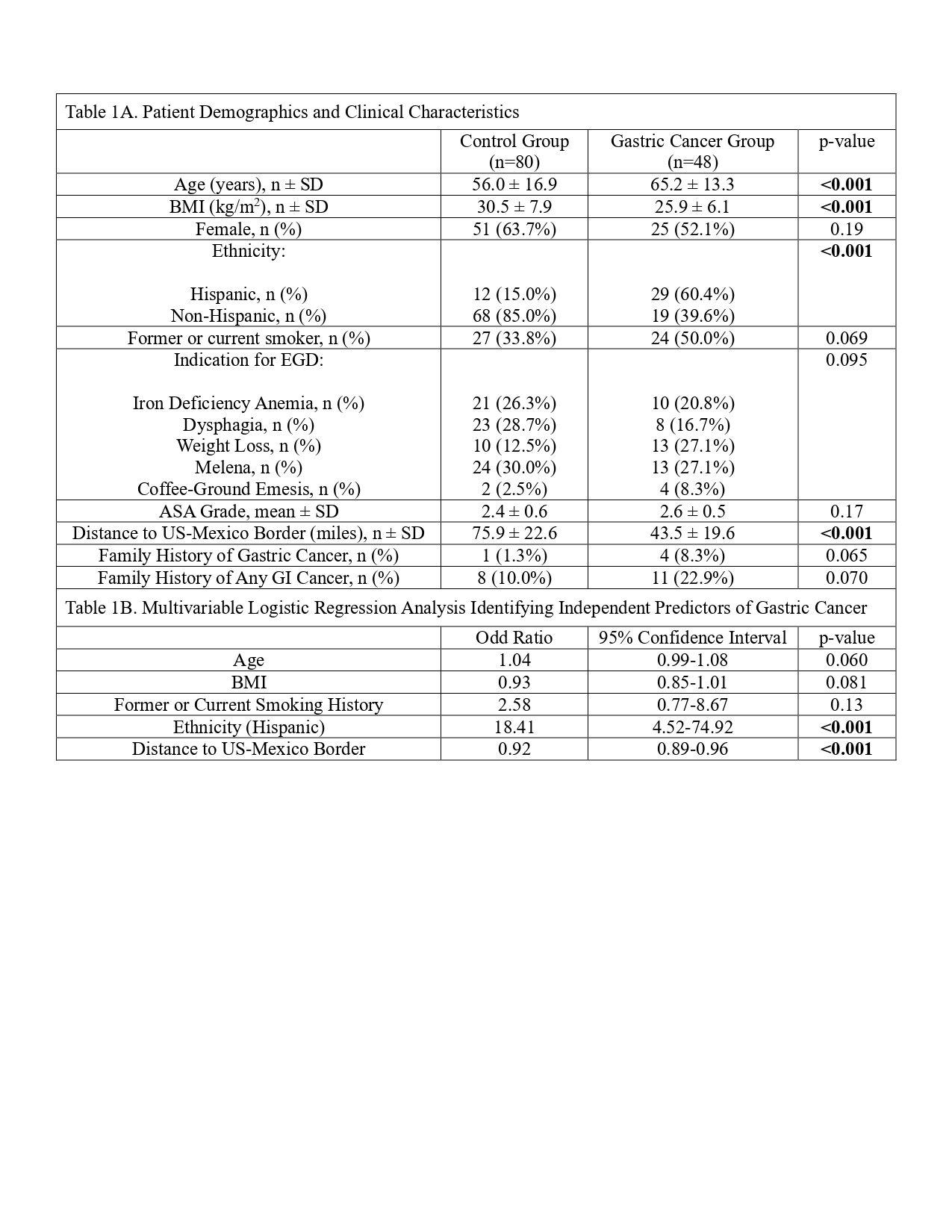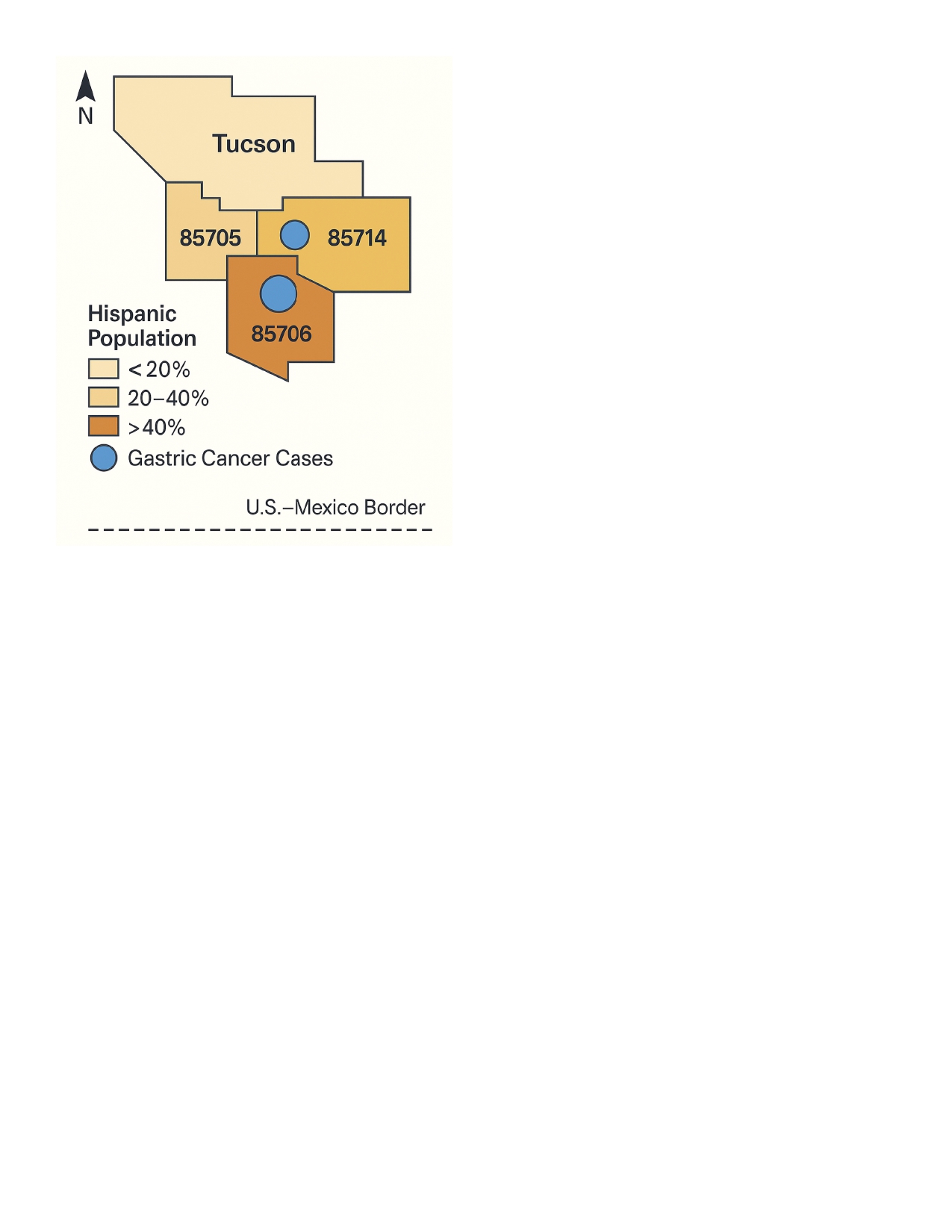Tuesday Poster Session
Category: Stomach and Spleen
P6314 - Bridging the Divide: Hispanic Health Disparities in Gastric Cancer Near Arizona’s Southern Border
Tuesday, October 28, 2025
10:30 AM - 4:00 PM PDT
Location: Exhibit Hall

Samuel Cheong, DO
University of Arizona College of Medicine
Tucson, AZ
Presenting Author(s)
Samuel Cheong, DO1, Jaime Scott, MD2, Franklin Liu, MD1, Akira Folk, DO2, Mohamad Omar Diab, MD3, Brandon Witten, MD2, Juanita L.. Merchant, MD, PhD4
1University of Arizona College of Medicine, Tucson, AZ; 2Banner - University of Arizona Tucson, Tucson, AZ; 3Canyon Vista Medical Center, Sierra Vista, AZ; 4University of Arizona Cancer Center, Tucson, AZ
Introduction: Gastric cancer disproportionately affects Hispanic populations in the United States, with rising incidence and frequent diagnoses at advanced stages. Socioeconomic and demographic factors may contribute to these disparities. We aimed to identify independent predictors of gastric cancer among patients in Southern Arizona and examine differences in clinical characteristics between gastric cancer patients and matched controls.
Methods: We conducted a case-control study of 128 patients who underwent esophagogastroduodenoscopy (EGD) at Banner University Medical Center Tucson between July 2014 and April 2025. Cases (n=48) had histologically confirmed gastric adenocarcinoma. Controls (n=80) were matched based on similar EGD indications. Demographic and clinical data—including age, gender, race, ethnicity, BMI, smoking status, ASA grade, residential distance to the US-Mexico border, and family history—were collected. Student’s t-tests and chi-square or Fisher’s exact tests were used for univariate comparisons. Multivariable logistic regression was performed to identify independent predictors of gastric cancer. SPSS was used for statistical analysis, with p< 0.05 considered statistically significant.
Results: Compared to controls, gastric cancer patients were older (65.2 ± 13.3 vs. 56.0 ± 16.9, p< 0.001), more frequently Hispanic (60.4% vs. 15.0%, p< 0.001), had lower BMI (25.9 ± 6.1 vs. 30.5 ± 7.9, p< 0.001), and lived closer to the US-Mexico border (43.5 ± 19.6 vs. 75.9 ± 2.6 miles, p< 0.001). There were no significant differences in gender, smoking status, EGD indication, ASA grade, or family history of gastrointestinal cancers. On multivariable analysis, Hispanic ethnicity (OR 18.41, 95% CI 4.52–74.92, p< 0.001) and closer proximity to the US-Mexico border (OR 0.92, 95% CI 0.89–0.96, p< 0.001) were independently associated with gastric cancer. Age, BMI, and smoking status were not significant in the adjusted model.
Discussion: Hispanic ethnicity and proximity to the US-Mexico border are strong independent predictors of gastric cancer in Southern Arizona. These findings underscore the urgent need for targeted screening and early detection strategies tailored to high-risk Hispanic communities. Culturally sensitive interventions addressing socioeconomic barriers, language obstacles, and healthcare access could play a crucial role in mitigating gastric cancer disparities. Future studies should explore risk-based surveillance to reduce the burden of gastric cancer in this vulnerable population.

Figure: Table 1A. Patient Demographics and Clinical Characteristics. Table 1B. Multivariable Logistic Regression Analysis Identifying Independent Predictors of Gastric Cancer.

Figure: Figure 1. Gastric cancer cases (blue circles) mapped within Tucson ZIP codes, illustrating Hispanic population density categorized as <20% (beige), 20–40% (orange), and >40% (brown).
Disclosures:
Samuel Cheong indicated no relevant financial relationships.
Jaime Scott indicated no relevant financial relationships.
Franklin Liu indicated no relevant financial relationships.
Akira Folk indicated no relevant financial relationships.
Mohamad Omar Diab indicated no relevant financial relationships.
Brandon Witten indicated no relevant financial relationships.
Juanita Merchant indicated no relevant financial relationships.
Samuel Cheong, DO1, Jaime Scott, MD2, Franklin Liu, MD1, Akira Folk, DO2, Mohamad Omar Diab, MD3, Brandon Witten, MD2, Juanita L.. Merchant, MD, PhD4. P6314 - Bridging the Divide: Hispanic Health Disparities in Gastric Cancer Near Arizona’s Southern Border, ACG 2025 Annual Scientific Meeting Abstracts. Phoenix, AZ: American College of Gastroenterology.
1University of Arizona College of Medicine, Tucson, AZ; 2Banner - University of Arizona Tucson, Tucson, AZ; 3Canyon Vista Medical Center, Sierra Vista, AZ; 4University of Arizona Cancer Center, Tucson, AZ
Introduction: Gastric cancer disproportionately affects Hispanic populations in the United States, with rising incidence and frequent diagnoses at advanced stages. Socioeconomic and demographic factors may contribute to these disparities. We aimed to identify independent predictors of gastric cancer among patients in Southern Arizona and examine differences in clinical characteristics between gastric cancer patients and matched controls.
Methods: We conducted a case-control study of 128 patients who underwent esophagogastroduodenoscopy (EGD) at Banner University Medical Center Tucson between July 2014 and April 2025. Cases (n=48) had histologically confirmed gastric adenocarcinoma. Controls (n=80) were matched based on similar EGD indications. Demographic and clinical data—including age, gender, race, ethnicity, BMI, smoking status, ASA grade, residential distance to the US-Mexico border, and family history—were collected. Student’s t-tests and chi-square or Fisher’s exact tests were used for univariate comparisons. Multivariable logistic regression was performed to identify independent predictors of gastric cancer. SPSS was used for statistical analysis, with p< 0.05 considered statistically significant.
Results: Compared to controls, gastric cancer patients were older (65.2 ± 13.3 vs. 56.0 ± 16.9, p< 0.001), more frequently Hispanic (60.4% vs. 15.0%, p< 0.001), had lower BMI (25.9 ± 6.1 vs. 30.5 ± 7.9, p< 0.001), and lived closer to the US-Mexico border (43.5 ± 19.6 vs. 75.9 ± 2.6 miles, p< 0.001). There were no significant differences in gender, smoking status, EGD indication, ASA grade, or family history of gastrointestinal cancers. On multivariable analysis, Hispanic ethnicity (OR 18.41, 95% CI 4.52–74.92, p< 0.001) and closer proximity to the US-Mexico border (OR 0.92, 95% CI 0.89–0.96, p< 0.001) were independently associated with gastric cancer. Age, BMI, and smoking status were not significant in the adjusted model.
Discussion: Hispanic ethnicity and proximity to the US-Mexico border are strong independent predictors of gastric cancer in Southern Arizona. These findings underscore the urgent need for targeted screening and early detection strategies tailored to high-risk Hispanic communities. Culturally sensitive interventions addressing socioeconomic barriers, language obstacles, and healthcare access could play a crucial role in mitigating gastric cancer disparities. Future studies should explore risk-based surveillance to reduce the burden of gastric cancer in this vulnerable population.

Figure: Table 1A. Patient Demographics and Clinical Characteristics. Table 1B. Multivariable Logistic Regression Analysis Identifying Independent Predictors of Gastric Cancer.

Figure: Figure 1. Gastric cancer cases (blue circles) mapped within Tucson ZIP codes, illustrating Hispanic population density categorized as <20% (beige), 20–40% (orange), and >40% (brown).
Disclosures:
Samuel Cheong indicated no relevant financial relationships.
Jaime Scott indicated no relevant financial relationships.
Franklin Liu indicated no relevant financial relationships.
Akira Folk indicated no relevant financial relationships.
Mohamad Omar Diab indicated no relevant financial relationships.
Brandon Witten indicated no relevant financial relationships.
Juanita Merchant indicated no relevant financial relationships.
Samuel Cheong, DO1, Jaime Scott, MD2, Franklin Liu, MD1, Akira Folk, DO2, Mohamad Omar Diab, MD3, Brandon Witten, MD2, Juanita L.. Merchant, MD, PhD4. P6314 - Bridging the Divide: Hispanic Health Disparities in Gastric Cancer Near Arizona’s Southern Border, ACG 2025 Annual Scientific Meeting Abstracts. Phoenix, AZ: American College of Gastroenterology.

